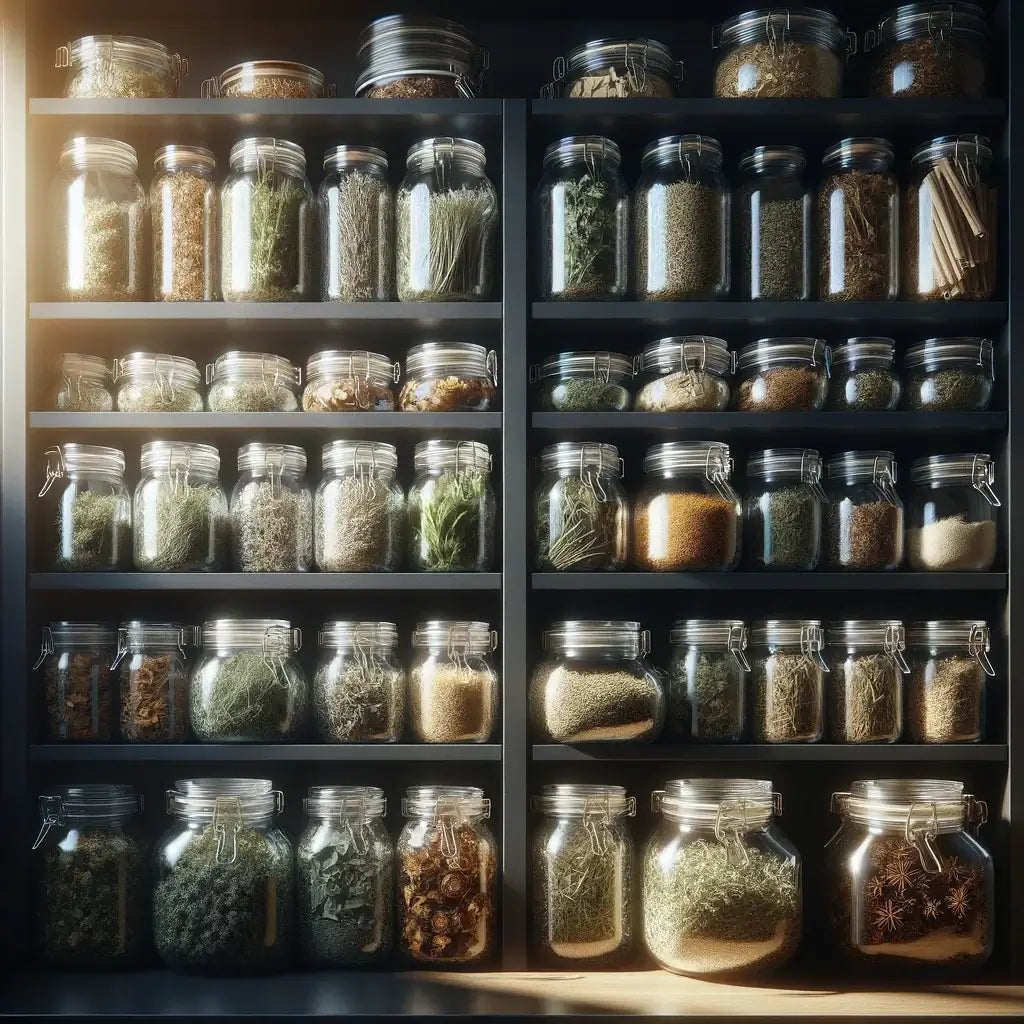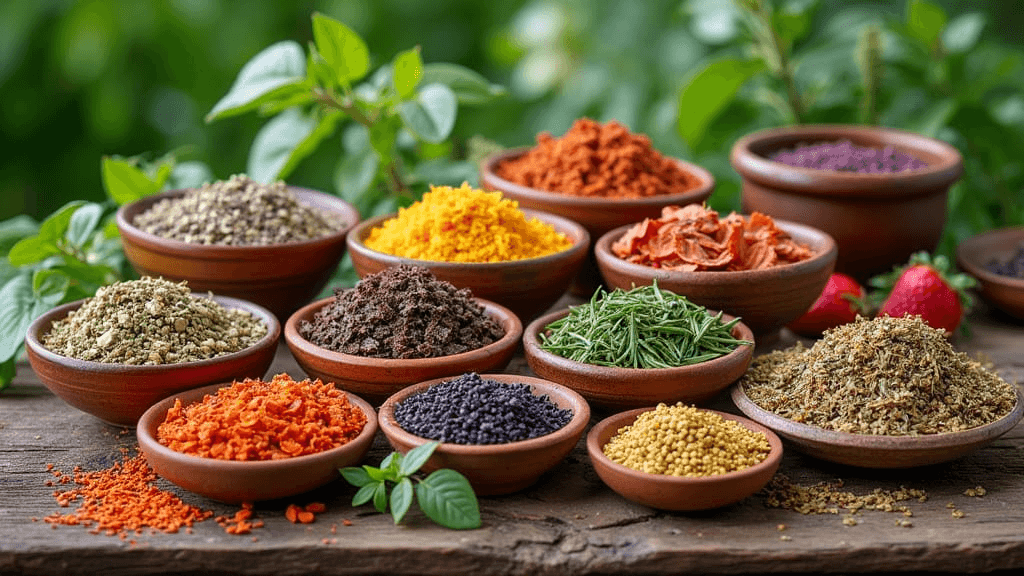How to Store Dried Herbs (Keep Flavor & Potency)
Last updated: August 28, 2025

Heat, light, oxygen, and moisture are the four forces that fade color, flatten aroma, and reduce activity in dried herbs. With a few simple habits—cool, dark, dry, and airtight—you can preserve freshness for months longer, whether you’re running a home apothecary or a professional workspace.
This guide turns best practices into clear steps. You’ll find a quick shelf-life reference by plant part, two proven storage methods (pantry and freezer), a container & packaging guide (glass, mylar, desiccants, oxygen absorbers), quality checks, troubleshooting, and an FAQ for common “how long/which jar/where to keep” questions.
At a Glance: The 6 Rules of Herb Storage
- Cool: Aim for room temp or cooler (55–70 °F). Keep away from stoves, ovens, dishwashers, and sunny windows.
- Dark: Store in a cupboard or closed bin; amber glass helps if shelves are exposed to light.
- Dry: Avoid steam and humidity. Don’t store above the range or next to kettles. Consider a small desiccant pack in long-term containers.
- Airtight: Use tight-lidded glass jars or food-grade mylar with proper seals. Minimize headspace and re-seal promptly after use.
- Label: Note herb name, plant part/cut, source or lot (if known), and packed/opened dates to support rotation and quality checks.
- Rotate: First-in, first-out. Keep frequently used jars small; store backup stock sealed and untouched until needed.
Quick placement tips
- Best: a cool, dark pantry or cabinet away from heat and moisture.
- Avoid: over the stove, near the dishwasher, or in direct sun.
- Smell check: don’t store next to strong odors (coffee, cleaning agents).
Shelf-Life Reference (Well-Stored, Dried Herbs)
Ranges below assume cool, dark, dry, airtight conditions. Freezer life assumes airtight, portioned containers, thawed while sealed to prevent condensation. Always rely on sensory checks before use.
| Plant Part / Form | Pantry (airtight, cool, dark) | Freezer (airtight, portioned) | Notes |
|---|---|---|---|
| Leaves & Flowers (e.g., lemon balm, chamomile, rose) | ~12–18 months | ~18–36 months | Most aroma-sensitive; protect from light. Freeze only if truly airtight. |
| Seeds & Fruits (e.g., fennel, anise, peppercorns) | ~18–36 months (whole) | ~24–48 months | Whole keeps longer than ground. Grind as needed. |
| Roots, Rhizomes & Bark (e.g., ginger chips, licorice, cinnamon) | ~18–24 months | ~24–36 months | Denser parts retain character longer if kept dry and airtight. |
| Powders (any finely milled herb/spice) | ~6–12 months | ~12–24 months | High surface area = faster aroma loss. Buy smaller amounts; use quickly. |
| Aromatic Peels/Flowers (e.g., citrus peel, lavender) | ~9–18 months | ~18–30 months | Volatiles fade sooner; amber glass helps. |
| Dried Culinary Mushrooms (e.g., shiitake, wood ear) | ~12–24 months | ~24–36 months | Keep very dry; add desiccant in humid climates. |
How to Tell Herbs Are Past Their Prime
- Sniff: Aroma should be distinct. A “cardboard” or flat scent = time to replace.
- Color: Faded, brownish greens or dull petals suggest oxidized stock.
- Crush test: Rub a pinch between fingers; strong fragrance on crush = good. Weak = stale.
- Brew test: Steep a small cup. If the cup is pale and flavor thin, rotate in fresher stock.
- Moisture check: Clumping or softness may indicate humidity ingress—inspect for mold; when in doubt, discard.
Method A: Pantry Storage

Best for herbs you reach for weekly. Keep daily-use amounts in small jars and store backup stock sealed and untouched until needed.
What you need
- Tight-lidded glass jars (amber preferred if shelves get light)
- Labels or painter’s tape + marker (name, part/cut, packed/opened dates)
- Optional: small food-safe desiccant packs for humid climates
- Optional: opaque bin or cabinet to block light
Steps
- Choose the spot: a cool, dark cabinet away from heat, steam, and sun (not above the stove or dishwasher).
- Right-size the jar: pick a jar that the herb will nearly fill to minimize headspace (less air = slower staling).
- Load and label: add herbs to the jar, include a small desiccant if humidity is high, then label with name, part/cut, packed date, and opened date.
- Seal promptly: after each use, re-seal immediately and return to the cabinet; don’t leave lids off during cooking (steam and odors migrate).
- Rotate stock: first-in, first-out. Keep one “working” jar; store backup stock sealed until you need a refill.
- Monthly check: quick sniff/color/crush test; if aroma is faint or color is dull, prioritize that jar for near-term use.
Do / Don’t
- Do keep herbs away from coffee, cleaning agents, and strong spices that can share odors.
- Do use amber or keep clear jars inside an opaque bin to block light.
- Don’t store over appliances that vent heat or steam.
- Don’t use oxygen absorbers for aromatic herbs you open often; they’re better for long, sealed storage (see freezer/long-term method).
Method B: Freezer Storage (Long-Term)
Freezing can slow oxidation and aroma loss when you need to store herbs for many months. Success depends on truly airtight packaging, small portions, and avoiding condensation during thaw.
What you need
- Freezer-grade, airtight containers (mason jars with good lids, hard-sided freezer containers) or food-grade mylar (≥4 mil) heat-sealed
- Portion strategy: small packs you can use up in 1–4 weeks after thawing
- Labels (herb, part/cut, lot/source if known, packed & frozen dates)
- Optional: oxygen absorbers for sealed, long-term backup packs (not for daily-opening jars)
- Optional: desiccant packs for humid climates (use sparingly; keep separate from oxygen absorbers)
Steps
- Pre-dry check: Ensure herbs are fully dried and room-temperature. Any residual moisture raises condensation risk.
- Portion: Divide into small units (e.g., 10–30 g or enough for 2–4 weeks of use). Smaller packs = fewer thaw cycles.
- Package airtight: Fill containers to reduce headspace; seal firmly. For mylar, heat-seal fully. If using oxygen absorbers, add them only to packs you’ll keep sealed for months.
- Label clearly: Herb, part/cut, packed date, frozen date. Add lot/source if available.
- Freeze promptly: Place toward the back of the freezer, away from door swings and strong odors.
- Thaw sealed: When you need a pack, remove it and let it return to room temperature while still sealed. Open only after it’s warmed to prevent moisture condensing on the herbs.
Good practices
- Single-use or few-use packs: Avoid repeated thaw/refreeze cycles.
- Odor management: Keep away from pungent foods; double-bag if needed to prevent scent transfer.
- Rotation: Use the oldest frozen packs first; keep a simple list so backups don’t languish.
- After thaw: Move contents to a small pantry jar and store as in Method A; finish within a few weeks for best flavor.
Avoid these mistakes
- Opening cold packs: This draws moisture onto the herbs. Always thaw sealed first.
- Large “family-size” bags: They encourage multiple thaw events and faster staling once opened.
- Mixing absorbers: Don’t combine oxygen absorbers and desiccants in the same small pack unless you understand target water activity; it’s usually unnecessary for culinary herbs.
Tip: For highly aromatic leaves and flowers, hard-sided containers protect against crushing; mylar works well for dense roots and barks.
Containers & Packaging: What to Use and When

The right container slows aroma loss and keeps humidity out. Match the package to how often you open it and where it lives (pantry vs. long-term backup).
Quick picks by use case
- Daily use (pantry): Tight-lidded glass jars, 4–16 oz, nearly full to reduce headspace.
- Backup stock (months): Food-grade mylar (≥4 mil) heat-sealed, or mason jars with excellent lids.
- Long holds (months–years): Mylar + heat seal; optionally add oxygen absorbers for dense, non-aromatic parts you won’t open for a long time.
- Humid climates: Add a small desiccant pack to larger sealed containers (avoid direct contact with herbs; pouch inside but not touching product if possible).
Glass jars (pantry champions)
- Pros: Inert, reusable, easy to see contents; great for leaves/flowers you open often.
- Cons: Light exposure fades color/aroma. Solution: store in a dark cabinet or use amber glass.
- Best practice: Choose a jar that the herb will nearly fill; label name, part/cut, packed & opened dates.
Food-grade mylar (backup & shipping)
- Pros: Excellent oxygen/light barrier; ideal for sealed backups and freezer packs.
- Cons: Requires a proper heat seal; not convenient for daily opening.
- Best practice: Portion small (1–4 week use per pack), heat-seal fully, label with dates; store flat in bin or box.
Lid quality & headspace
- Gasketed lids (silicone/rubber) seal better than loose screw-tops.
- Minimize headspace: less trapped air = slower staling. Use smaller jars as contents dwindle.
When (and when not) to use oxygen absorbers
- Use for sealed, long-term backups of dense parts (roots, bark, seeds) that you won’t open for months.
- Avoid in daily-open jars and highly aromatic leaves/flowers—opening defeats the benefit and you’ll likely prefer fresh rotation.
- Don’t mix oxygen absorbers and desiccants in small packs unless you are targeting a specific water activity; it’s usually unnecessary for culinary herbs.
Desiccant packs (humidity management)
- Use in larger, sealed containers or in very humid environments.
- Avoid direct contact with herbs; keep in its pouch and replace if the indicator shows saturation (if equipped).
Handling accessories that help
- Dedicated scoop/spoon: Keep moisture and kitchen steam out—never scoop with damp utensils.
- Small funnel: Reduces spills and exposure time while transferring.
- Opaque bin or door: Store clear jars behind a closed cabinet to block light.
Tip: For fragile leaves/flowers (e.g., chamomile, rose), hard-sided containers prevent crushing; reserve mylar for dense roots/barks or backups.
Quality Checks & Troubleshooting
Build a quick monthly habit: smell, look, crush, and brew. These simple checks help you decide when to rotate stock or adjust storage.
Monthly quality check
- Smell: Aroma should be distinct and characteristic. A faint, “cardboard” scent signals staling.
- Look: Greens should still look green; petals should retain color. Dull, brown, or grey tones = oxidation or light exposure.
- Crush: Rub a pinch between fingers. You should release a burst of fragrance. Weak response suggests age or poor sealing.
- Brew: Make a small test cup. If flavor is thin or pale, prioritize that jar for near-term use and refresh your backup plan.
Common issues and fixes
- Clumping or softness: Likely humidity ingress. Move herbs to a fresh, dry jar; add a small food-safe desiccant to larger sealed containers. Check storage location for steam exposure.
- Fast aroma fade: Too much headspace or light. Downsize to a smaller jar and store in a dark cabinet (or switch to amber glass).
- Mixed odors: Stored near coffee/cleaners or in a shared spice drawer. Relocate to an odor-neutral cabinet; avoid cross-scent items.
- Condensation after freezer: Opened while still cold. Next time, thaw sealed to room temp before opening; portion smaller packs.
- Crushed leaves/flowers: Use hard-sided containers for fragile botanicals; avoid vacuum levels that collapse delicate material.
When to discard
- Visible mold, off-smells (musty, sour), or signs of pests.
- Moisture damage that doesn’t resolve with drying and safe repackaging.
- Completely flat aroma/flavor after a brew test.
Simple rotation workflow
- Label everything: name, part/cut, packed & opened dates.
- Keep “working jars” small: refill from sealed backups as needed.
- First-in, first-out: place newer backups behind older ones.
- Quarterly audit: prioritize any jars approaching their range in the shelf-life table.
Note: If you ever suspect contamination, it’s safer to compost and replace.
FAQ: Storing Dried Herbs
How long do dried herbs last?
Well-stored leaves and flowers typically keep ~12–18 months; roots/bark/seeds ~18–24 months; powders ~6–12 months. In airtight, portioned freezer packs, some items can hold character longer. Always use sensory checks (smell, color, crush, brew) before use.
What containers are best?
For daily use, tight-lidded glass jars (amber if shelves get light). For backups and long holds, heat-sealed food-grade mylar (≥4 mil) or mason jars with excellent lids. Choose sizes that minimize headspace.
Should I freeze dried herbs?
Freezing helps for long holds if packaging is truly airtight and portioned small. Thaw sealed to room temperature before opening to avoid condensation. Move thawed herbs to a small pantry jar and finish within a few weeks.
Do I need oxygen absorbers or desiccant packs?
Optional. Oxygen absorbers suit sealed, months-long backups of dense parts (roots, bark, seeds) that you won’t open. Desiccants help in humid climates or larger sealed containers. Avoid mixing both in small packs and skip absorbers in jars you open often.
Where should I keep jars in the kitchen?
A cool, dark cabinet away from heat, steam, and sun—never over the stove or near the dishwasher. Keep away from strong odors (coffee, cleaning agents).
How do I know herbs are stale?
Flat aroma (“cardboard”), faded color, weak crush response, and thin brew flavor. Prioritize for near-term use or replace.
Clear or amber glass?
Amber if your shelves get light exposure. If using clear, store jars inside a closed cabinet or opaque bin to block light.
What should my label include?
Herb name, plant part/cut, source or lot (if known), packed date, and opened date. This supports rotation and quick quality checks.
Note: This information is for storage and quality only. Educational purposes; not medical advice.
Explore & Keep Your Shelf Fresh
Ready to rotate older jars and restock the essentials? Browse our curated botanicals, then store them using the methods above for lasting aroma and flavor.
- Shop Herbs & Spices — source fresh botanicals to refill your working jars.
- Stress Support Teas — calming blends that benefit from airtight, light-safe storage.






